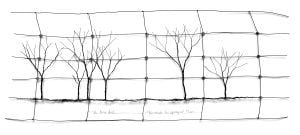‘The trees died because he poisoned them. He was trying to kill the radish, so he sprayed it and the trees with his boom spray and the trees died. He pushed them all up, then burnt them and put in a new fence.’

Tania Spencer
The Fenceline, 2022
wire, ringlock
70cm x 165cm x 3cm
This new work, The Fenceline, was unveiled in 25+Crossover, a selected exhibition initiated by the Western Australian Fibre and Textile Association (WAFTA) https://waftatwentyfiveplus.com.au/
at the Holmes a’ Court Gallery @ no. 10,
10 Douglas Street, West Perth
22 October to 12 November 2022
We were asked by WAFTA to challenge the customary use of materials and techniques of traditional fibre and textiles, and to use no more than 3 textile techniques. The independent panel selected 42 diverse artworks to be hung at the Holmes a’ Court Gallery.
For me the decision to use wire for this project was easy. I’ve been working in the area between textile process with alternative materials for almost 20 years. It’s a space I’m used to working in. So, my personal challenge was to re-fine the complexity and conceptual areas in my work.
Responding to the brief, the techniques I chose were the most minimal I could do and still have the work be classified as textile related – twined and plied wire on a woven pre-manufactured substrate – ringlock fence wire. The ringlock wire held the subject matter inherently, with the plain wire being perfect to explain the form of the trees affected by spraying, stick-like dead limbs. This leads me into the why of making this work.
Whats happening
The demise of so many canopy trees in our local area. There is clearing of road verges by Main Roads for safety and wildlife avoidance. Farmers clearing the remnant bush patches and sentinel paddock trees due to the use of GPS technology in broadacre farming. Furthermore, continual clearing, re-fencing, realignment with larger paddocks is taking place all over the wheatbelt. It really is a second wave of clearing.
I feel sad when I drive the roads into town now, the North and South entrances are denuded of trees and barren in appearance, compared to what they were only recently. I know that google earth shows this. I was once proud of the appearance of our town and our community. I’m not so much now, I’m sad that farmers are continuing to knock down tree after tree after tree. I’m sad that agronomists are not looking at a sustainable agriculture
I’m sad that the Shire of Lake Grace is directing tree after tree after tree to be cut down, in its monthly zeal to appease the tree cutters that come to town. I’m sad that townspeople cut trees down and remove limbs for firewood within the town recreation area. I’m sad that there is no regard and leadership by the Council for the preservation of the trees we have left. I’m sad that on the morning of this exhibition opening, I woke up to the news of Shire of Lake Grace being fined $75,000 for unapproved clearing of native bush. I’m not sad they were fined, I’m sad that it happened.
Conveying the message
Methods used in the work to convey the message were the pictorial formal landscape that was stark and colourless, with no shadow. I wanted to present a very unromantic view of the rural landscape. Referring to art history I used traditional framing conventions in art; the centralised writing, recalling golden nameplates in traditional gilded frames denoting the importance of the subject in the work. The materials are of the rural landscape and the very subject matter at hand.
The Curatorial siting of the work by Andrew Varano was excellent, to set up the relationships between Jane Argent’s – Where Do We Record Our History? and Joy Denise Scott’s – Real Bodies Have Their Lives Stitched Into Them: Burial Gown and my piece The Fenceline. My work is about clearing and the death of trees, whereas Jayne’s books share the historical use of the materials of clearing and Denise’s gown is about the subject of death.
Siting such works together results in the sum of the works to be greater than they are individually. It highlights the layering of society, that we all have different perspectives and standpoints.
You can see all the artists’ works in the catalogue https://www.wafta.com.au/blog/twentyfive-website
Lastly Congratulations to the WAFTA committee and exhibition committee for conceiving and delivering a diverse and thoughtful exhibition. The cavernous industrial space at the Holmes a court Gallery gives each individual work ample area to breathe.
#landclearing #agricultural #notaccidental #modernfarmpractices #newfenceline #spraying #trees #treeremoval #notright #chemicalexfoliation


